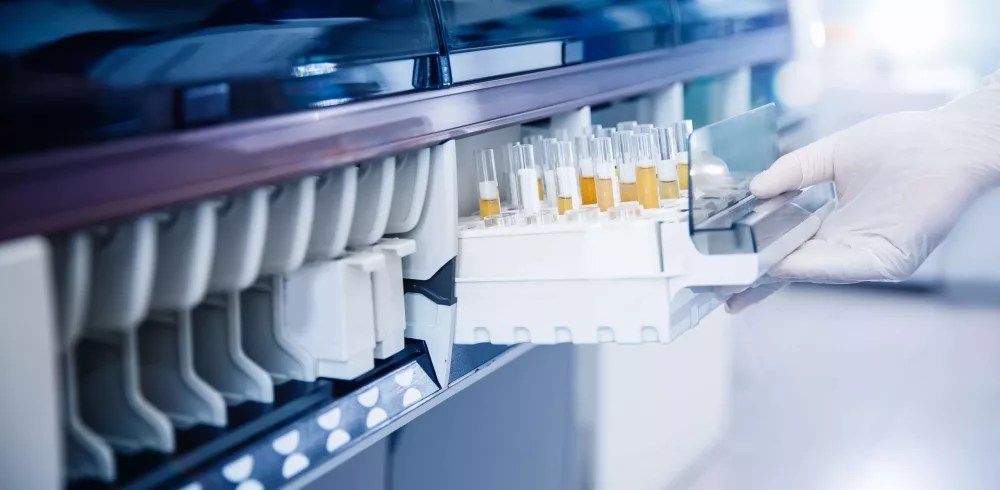With the potential to boost productivity by up to 90 per cent while reducing cost per specimen, laboratory automation is reshaping medical research. In this article, Dave Walsha, sales manager at drive system supplier EMS, explores some of the key points to consider for successful implementation of the latest in automation technology.
Finding new compounds for novel medicines and materials is traditionally not an easy process. It could require hours of complex synthesis steps, analysis and trial and error before the desired compound is formed.
But the rise of autonomous laboratories could transform the way we discover and manufacture these novel compounds. A 2023 paper published in Nature introduced the A-Lab, an autonomous laboratory capable of planning, performing and interpreting its own experiments to create desired compounds. This is all thanks to a combination of artificial intelligence, access to historical literature data and advanced robotic technology.
Laboratories looking to replicate the A-Lab and benefit from the advantages of an automated system might be keen to explore their options. But before embracing automation, there are several key points for both lab managers and equipment designers to consider.
Functionality and flexibility
First, let’s think about what and why you need to automate. Is the goal to free up valuable time of senior scientists, or to increase throughput and accuracy on a single procedure?
Deciding this goal will help dictate the level of autonomy. A semi-automated process, for example, is often a good fit for laboratories looking to improve individual steps in the experimental method. Typically, these are simple, repetitive tasks, such as liquid dispensing or mixing.
Another element to consider is how well the automation technology can adapt to new methodologies. In the scientific community, advancements can come quickly and unexpectedly. For businesses to keep up, their technology must be just as adaptable.
Opting for a system with a modular design can help, enabling additional systems and functionalities to be added on seamlessly. Alternatively, a reprogrammable robot with a user-friendly interface can also facilitate a system agile enough to switch across different workstations.
Traceability
To comply with relevant organisations and to maintain industrial accreditation, documentation for the entire process is essential. Methodologies must be followed closely to ensure accurate and precise experiment results.
Therefore, it’s crucial that the system can communicate with other devices to share and record procedures and analysis data. Integration with laboratory information management systems (LIMS) allows for all this data to be collated in one place, simplifying the workflow for reporting scientists.
Equipment design
Demands placed on laboratory automation systems can be exceptionally high. High throughput labs may analyse thousands of samples a day. As such, it’s imperative that the system is designed to facilitate long hours of continuous operation. Reliability is essential. Systems repeatedly failing or hardware malfunctioning results in downtime and increased cost, as well as disruption to vital projects.
Working with suppliers experienced in the medical technology industry can be advantageous. An in-depth understanding of the high demands of the sector means an experienced designer can help in avoiding common pitfalls and ensure the system is up to scratch.
Let’s consider the robotics of the automation system as an example. Moving arms, grippers, centrifuges and conveyer belts commonly found in automated laboratories will all be driven by one or more types of DC motor. But with hundreds of DC motors on the market, all with varying performance, dynamics, size, lifespan and torque, how do you go about selecting the right one?
Consultation with an expert in delivering DC motors for medical technology applications can help. EMS, for example, has supplied DC motors for projects ranging from market-leading prosthetics and medical imaging technology to laboratory tools and mobility aids. And its exclusive partnerships with leading manufacturers such as FAULHABER mean it has the product catalogue required to provide a unique and tailored solution for the application.
Advanced artificial intelligence and robotics technologies offer potential for scientific and medical discoveries like never before. And as innovation in medicine and material science continues, the role of laboratory automation becomes even more crucial. System designers, supported by experienced suppliers, will contribute significantly to the success of these automation solutions.
Manufacturing & Engineering Magazine | The Home of Manufacturing Industry News















